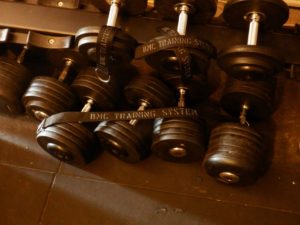- Calls to this hotline are currently being directed to Within Health, Fay or Eating Disorder Solutions
- Representatives are standing by 24/7 to help answer your questions
- All calls are confidential and HIPAA compliant
- There is no obligation or cost to call
- Eating Disorder Hope does not receive any commissions or fees dependent upon which provider you select
- Additional treatment providers are located on our directory or samhsa.gov
Muscle Dysmorphia & Co-Occurring Substance Abuse: What are the Connections?

Contributor: Courtney Howard, B.A., Executive Assistant at Eating Disorder Hope and Addiction Hope
Muscle dysmorphia is a form of body dysmorphic disorder (BDD) in which the individual has a distorted perception of his or her body build and subsequent preoccupation with building muscle mass. In cases of muscle dysmorphia, also referred to as “bigorexia,” those struggling typically see themselves as too small or frail, leading to extreme measures to gain muscle mass. This often includes the use of anabolic steroids.
In addition to abusing performance-enhancing drugs, individuals with muscle dysmorphia often turn to other substances seemingly unrelated to muscle development. This can be to cope with the psychological effects of their condition, much in the same way that those with eating disorders often have co-occurring substance use disorders.
Psychological Effects of Muscle Dysmorphia
A 2005 study [1] found that 22.2 percent of males with BDD struggle with muscle dysmorphia. Most of these individuals also had other symptoms of BDD unrelated to their muscle mass. It is difficult to know the true prevalence of muscle dysmorphia among the general population because it is so often underreported and misdiagnosed.
Individuals with muscle dysmorphia typically have a normal body build, often developing an extreme amount of muscle mass due to the obsessive behaviors in which they engage as a response to their self-distortions. Someone with this mental health condition might engage in repeated behaviors similar to eating disorders, including body-checking, calorie-counting, disordered eating, and compulsive exercise (primarily weight-lifting).
Also similar to eating disorders, muscle dysmorphia is characterized by intrusive, obsessive thoughts. This is why eating disorders and BDD are both often compared to obsessive-compulsive disorder (OCD), as the obsessive thoughts and compulsive actions in these cases are undeniable. It then follows that individuals without proper coping skills would turn to substances for relief from this cycle.
Muscle Dysmorphia & Substance Abuse
Anabolic steroid abuse is common among those with muscle dysmorphia, as these substances can help individuals increase muscle mass. However, this comes at a steep price. In addition to the physical side effects of anabolic steroids, there are intense long-term effects on mood and behavior since these drugs significantly alter dopamine and serotonin levels in the brain.
As with any co-occurring conditions, the National Institute on Drug Abuse reports that these effects on the brain often worsen the symptoms of muscle dysmorphia and any other mental health issues that might be present.
The same 2005 study mentioned above also uncovered that, aside from anabolic steroid abuse, individuals grappling with muscle dysmorphia had a “significantly higher lifetime prevalence of substance use disorders.” This suggests that individuals likely turn to substances to cope with symptoms of their muscle dysmorphia.
How This Relates to Eating Disorders
Eating disorders and BDD often co-occur, and those within the eating disorder community who do not have BDD still typically have some form of body image concerns. Muscle dysmorphia often comes with disordered eating and a similar pattern of thoughts and behaviors.
Individuals with muscle dysmorphia often have a rigid set of rules when it comes to food and exercise. This can take many forms, but orthorexia is often seen with this form of BDD.
 Orthorexia is an extreme focus on “clean” or “healthy” eating. This is an eating disorder that often slips between the cracks since it is arguably socially acceptable to obsess over this kind of disordered eating. Typical foods include lean meats, organic vegetables, and juices “cleanses.”
Orthorexia is an extreme focus on “clean” or “healthy” eating. This is an eating disorder that often slips between the cracks since it is arguably socially acceptable to obsess over this kind of disordered eating. Typical foods include lean meats, organic vegetables, and juices “cleanses.”
Any deviation from a set meal plan typically causes an incredible amount of distress to someone with orthorexia. Eating out with friends is no longer an option, as food can only be consumed in a controlled environment in which the individual is aware of the exact quality of food he or she is consuming.
Substance abuse is also common with eating disorders, as individuals bounce between maladaptive coping mechanisms to manage unwanted feelings.
What Needs to be Done
Further research must be conducted to fully understand the relationship between muscle dysmorphia and substance abuse. All conclusions drawn as of now are mostly speculation based on the close ties between BDD and eating disorders. However, with further research, we can gain a deeper understanding of what can be done for the prevention and treatment of muscle dysmorphia and co-occurring substance abuse.
Community Discussion – Share your thoughts here!
Have you or your loved one struggled with muscle dysmorphia? What types of treatment and/or support have worked well?
 About the Author: Courtney Howard is the Executive Assistant for Eating Disorder Hope and Addiction Hope. She graduated summa cum laude with a B.A. from San Diego State University, holds a paralegal certificate in Family Law, and is a Certified Domestic Violence Advocate. After obtaining her certification as a life coach, Courtney launched Lionheart Eating Disorder Recovery Coaching in 2015 and continues to be a passionate advocate for awareness and recovery.
About the Author: Courtney Howard is the Executive Assistant for Eating Disorder Hope and Addiction Hope. She graduated summa cum laude with a B.A. from San Diego State University, holds a paralegal certificate in Family Law, and is a Certified Domestic Violence Advocate. After obtaining her certification as a life coach, Courtney launched Lionheart Eating Disorder Recovery Coaching in 2015 and continues to be a passionate advocate for awareness and recovery.
References:
[1]: Pope, C. G., Pope, H. G., Menard, W., Fay, C., Olivardia, R., & Phillips, K. A. (2005). “Clinical features of muscle dysmorphia among males with body dysmorphic disorder.” Body Image, 2(4), 395–400. http://doi.org/10.1016/j.bodyim.2005.09.001The opinions and views of our guest contributors are shared to provide a broad perspective of eating disorders. These are not necessarily the views of Eating Disorder Hope, but an effort to offer discussion of various issues by different concerned individuals.
We at Eating Disorder Hope understand that eating disorders result from a combination of environmental and genetic factors. If you or a loved one are suffering from an eating disorder, please know that there is hope for you, and seek immediate professional help.
Last Updated & Reviewed By: Jacquelyn Ekern, MS, LPC on August 2, 2016
Published on EatingDisorderHope.com

The EatingDisorderHope.com editorial team comprises experienced writers, editors, and medical reviewers specializing in eating disorders, treatment, and mental and behavioral health.

